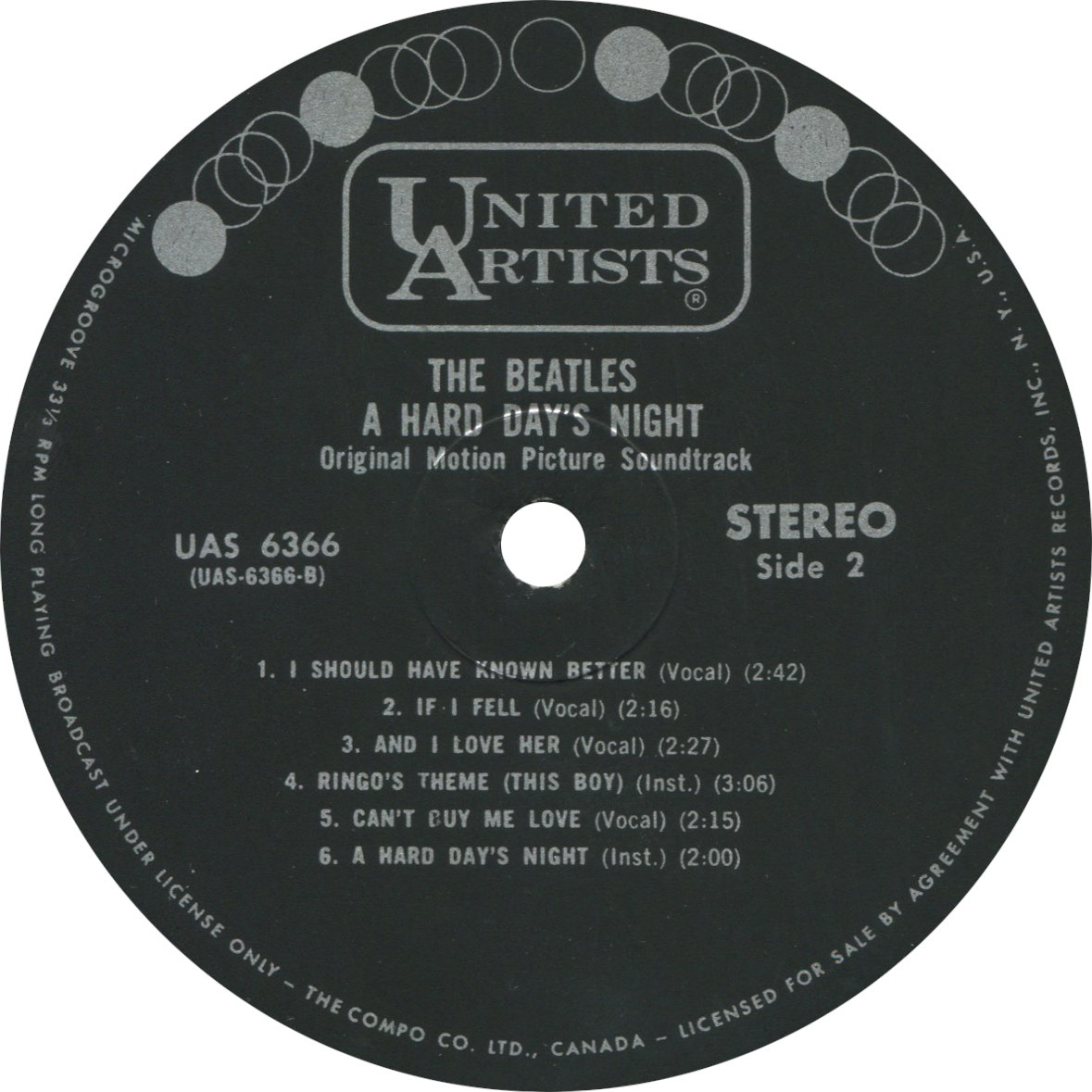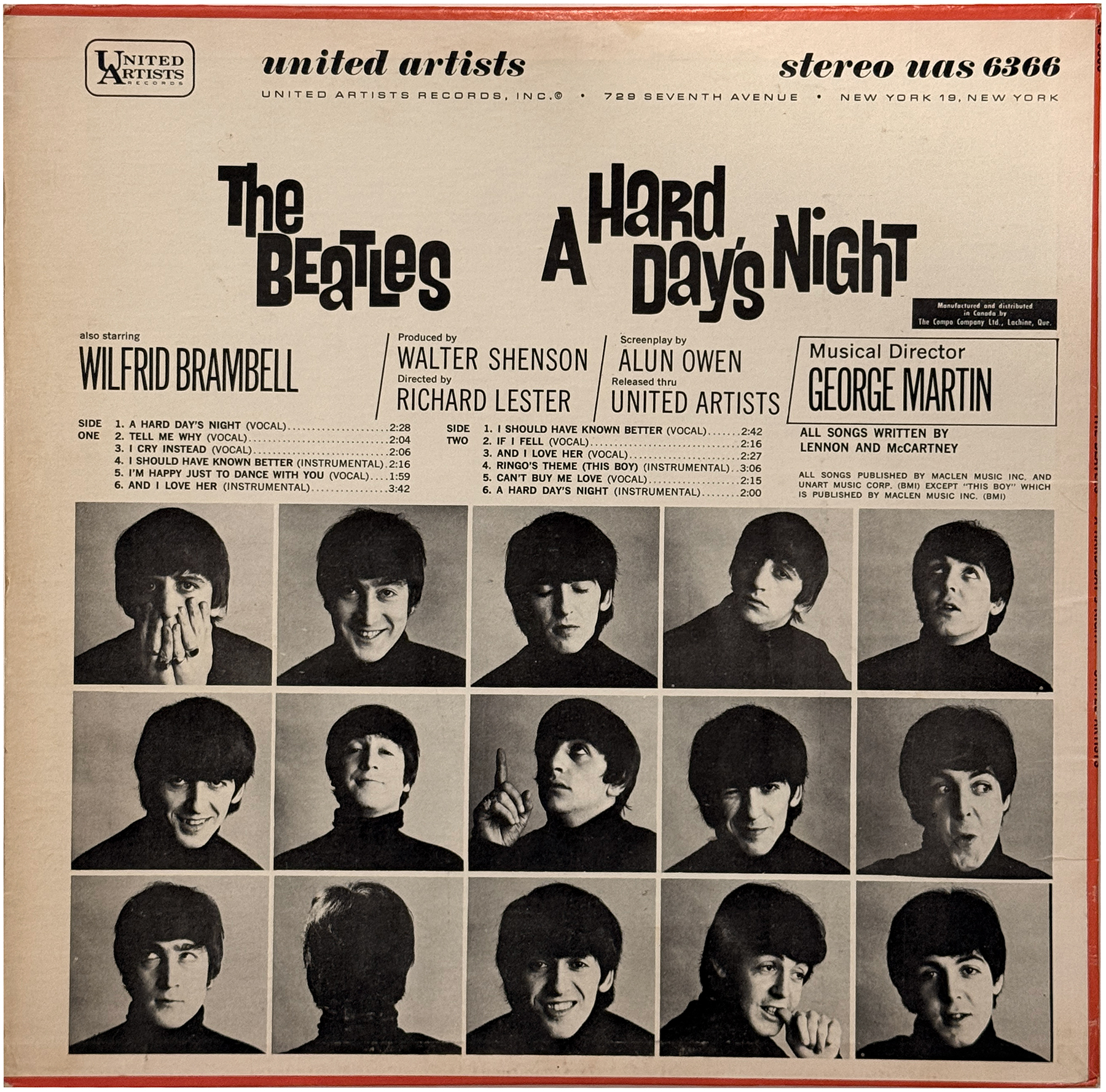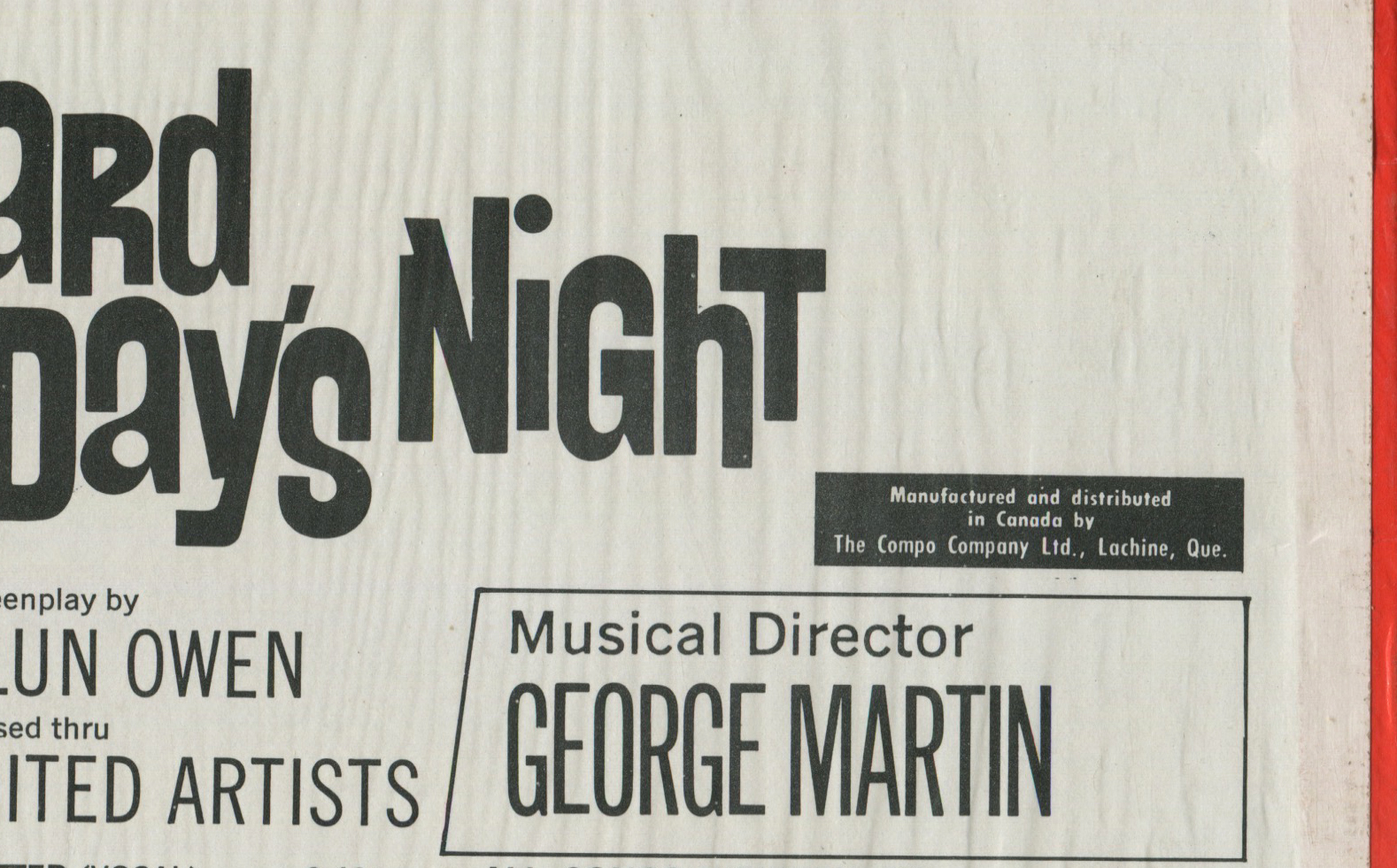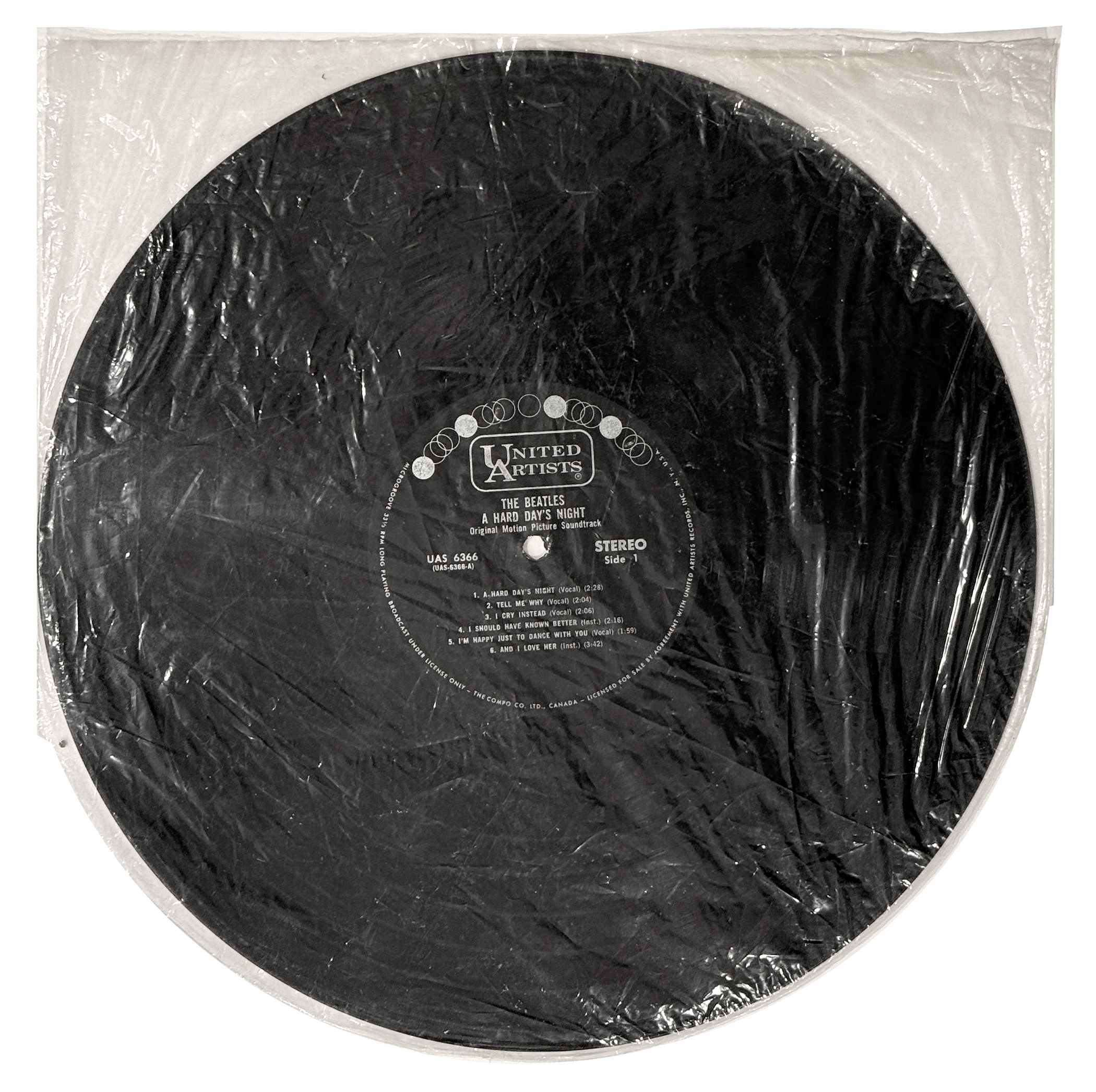← A Hard Day's Night Variations List
A Hard Day's Night
(US Format)
LP.3366.UA1.5 | UA Black and Silver STEREO (Compo)
Wide straight inner seam.
Variation LP.3366.UA1.5 is recognized by its STEREO BLACK labels. A Hard Day's Night was originally only released in Mono, the first stereo pressing of the album arrived a few months later in early 1965. This first stereo pressing has a black and silver UA stereo label, and was found in two different types of covers. Even though the album was sold as stereo, only the instrumental tracks were true stereo.


Availability
This first black label STEREO variation (LP.6366.UA1.5) was available between early 1965 and 1970 (approximately 5 years). It was the only stereo configuration of the album before the label design changed to the UA tan label. This variation was repressed many times between 1965 and 1970, but sold in far lower numbers than mono copies before 1968 (5000 vs 250 000 according to some reports).
General Information
Album notes and technical information being sent from the USA, Canadian pressings had "I'll Cry Instead" written as "I Cry Instead". This mistake was also carried onto the STEREO pressing.
Another interesting fact about the stereo version is that, as was the case in the USA, only the George Martin instrumental tracks were presented in true stereo, the Beatles tracks were in fact fake (or processed for stereo) mixes. As the story goes (see Bruce Spizer's "The Beatles Swan Song" book, p. 32), United Artists only received the mono master tapes of the Beatles tracks in early June. UA wanting to release the album sooner than later and capitalize on the wave the movie would create, they decided not to wait for the stereo mixes (that would arrive just a few days before the intended album release date) and "created" fake stereo mixes out of the mono tracks.
A similar process (under different names like duophonic, rechannelled, fake, processed for stereo, etc.) was often used for other tracks in the course of the Beatles' North American catalogue, namely the first stereo pressings of Beatlemania, Twist and Shout or Long Tall Sally). It consisted of copying the mono master on two separate tracks (right and left channels), and then applying significant differences between the two, like equalization, echo, volume changes, etc., in order to create an IMPRESSION of stereo. The result is usually underwhelmingly washout out in echo and hard panning (everything is either hard left or hard right).
In the end, it seems that ALL CANADIAN stereo pressings feature the mix with fake stereo Beatles tracks and true stereo instrumentals. A true stereo mix of the whole album was apparently never used in Canada. It is particularly obvious when listening to "Tell Me Why": the vocals jump subtly from left to right, as if John and the band replied to each other. The real UK stereo mix, in comparison, does not have that odd vocal dance effect, and the stereo field is much more natural and spread out.
Pressing Information
These records were pressed from the same masters as their US counterparts and they therefore have the same "fake stereo" mix.
Production of major orders (like The Beatles) was moved from Lachine to the new Cornwall plant that opened in 1963 around the time the album was issued. It is not known with certainty where this stereo variation was pressed; normally, the transition to Cornwall would have been completed, but as suggested by some collectors, both plants could have still been used to meet high demand and tight deadlines in early 1965.
It is important to keep in mind that although the cover artwork identifies the Lachine plant up until the 1970s, most copies (if not all) were actually pressed in Cornwall.
LP.6366.UA1.5 pressings have a dedicated stereo matrix number:
Side 1: UAS-6366 A-1A 1
Side 2: UAS-6366 B-1A1

Cover
The stereo cover is very siilar to its mon counterbart; uses the same slick as the previous 3 variations (see the stereo underslick), but the slick is trimmed differently to show the stereo banner. The back slick also has the stereo information, otherwise the rest remains identical.


There were five different jacket construction types (differentiated by the shape of the cardboard inner seam - where the parts of the cardboard frame are joined inside the jacket).
Stereo pressings can be found with either an angled/curved construction or a wide straight inner seam construction. Early stereo pressings would have the angled curved (possibly until 1969), while the straight cut inner seam pressings would be later, between 1969-1970.
This black stereo variation (LP.6366.UA1.5) can be found with either Version 2, or Version 5 configuration.
Version 1 – Straight-cut with rounded outer edges

Version 2 – Angled and curved inner seams

Version 3 – Narrow straight-cut inner seams

Version 4 – Seamless construction

Version 5 – Wide straight-cut inner seams

Otherwise, the artwork for this Canadian pressing includes a manufacturing notice indicating they supposedly were pressed at the Lachine Compo plant near Montreal. The black squared marker is found on all copies up until the 1970s, but it is highly unlikely that all copies of the album were pressed there (if any!). Most of the production would have been moved to the Cornwall plant, making the Lachine notice erroneous, or at most, true for a very short period of time.

Packaging
Copies of A Hard Day's Night were sealed in a thick loose poly bag wrapper.
The discs were not placed in a usual paper sleeve, but rather, they were housed in a very distinctive semicircle plastic inner sleeve:

Sales
While sales estimates for mono copies projected that 200 000-250 000 copies were sold in Canada, stereo copies sold far less before 1968 and estimates range around only 5000 copies, making the original stereo pressing much harder to find today. Unfortunately, no official sales figures have been documented (like with Capitol sales numbers).